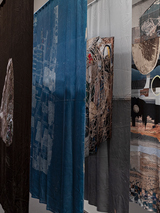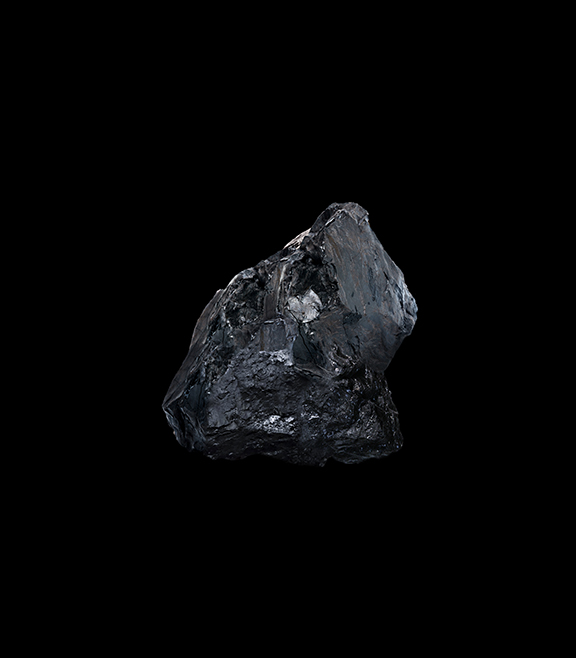Ecotopian Library


The bundle's core was a ball of tightly wound 3M adhesive tape (black, red, blue, and yellow) accumulated from the remnants of an art exhibition in Boulder, Colorado in 2017. The tape mound, wadded into a wide material mass, was the glutinous foundation for objects hastily tied together to build an impenetrable corpus of carbon and polyethylene-based matter.
Upon the collapse of a stellar nursery over 4.5 billion years ago, the conditions for Minnesota Mining and Manufacturing Company (or 3M) were born. In the ambiguous impassive encumbrance of outer space, hydrogen gas nebulas became so dense that nuclear reactions occurred. Under the pressures of gravitational force, dust-filled clouds collapsed to form stars. Stars fueled the universe by fusing hydrogen and helium (two of the lightest elements) with each other. When a star finally exhausted its hydrogen fuel, it began a shattering transformation, producing ever-weightier elements until it eventually reached a point of crisis. Carbon (atomic number 6) was built up by nuclear fusion in bigger stars, and parts were welded together from hot debris that jettisoned out of orbit during an explosion of a previous supernova, called a planetesimal. Element 6 was present in the atmospheres of many planets, usually as carbon dioxide.
In 1655, Dutch astronomer Christiaan Huygens discovered Titan, Saturn's largest moon. Titan had hundreds of times more natural gas and other liquid hydrocarbons than all the known oil and natural gas reserves on Earth. Today's scientists surmised the stew on Titan was only a single element away from crude oil. Titan's hydrocarbons continually rained from the sky onto the fulminating moon, and accumulated into capacious deposits of lakes and dregs of dunes.
During the earth's core accretion, planetesimal elements sank to the planet's substratum. A procession of sinking elements was governed by iron (element 26), the fated mineral that was responsible for the supernova explosion that destroyed a parent star. As plebeian iron sunk into the planetary core, it was accompanied by its more striking stannic sisters. While elements lighter than iron were formed by nuclear fusion within stars, elements heavier than iron were formed during the parent star's death.
The conditions that would eventually create coal (which is not an element but a series of compounds including hydrogen, nitrogen, oxygen, sulfur, arsenic, selenium and mercury) began to develop about 300 million years ago during the Carboniferous period. During this time, the Earth was covered in wide, shallow seas and dense forests. Trees climbed eight stories tall, and spawned graceful leaves that sat atop razor-thin trunks. Plants were evolving, using cellulose and lignin to stay upright. When seas flooded forests, verdure vegetation became matted at the bottom of swampy wetlands. Algae, mosses, and peats were entombed under the weight of overlying mud and acidic waters. As plant debris sifted deeper underground, it encountered increased temperatures and higher pressure. Sub-bituminous carbon swelled and released, and beneath the mountains grew a fossilized forest known as a coal seam. Slow moving microbes that lived in the coal and shale beds deep in the ocean ate the ancient buried carbon reserves.
At various times in Colorado's geological past, low-lying wetlands were buried. Peat was made through an accumulation of partly decayed vegetation that had undergone a transformation through carbonization. Peat is not quite coal, but can metamorphose into coal under optimal circumstances. Coal is a combustible sedimentary rock formed from ancient vegetation, consolidated between other rock strata and transformed by the combined effects of microbial action, pressure, and heat over a considerable time period. It is time-dependent; the 'coalification' process can't be rushed or slowed. Varied in properties, coal can yield prismatic purples, blues, or greens, with different scales or layers, each with its own characteristic feature, ductile, malleable, matte, and lustrous. Alchemists noted coal could be transformed into diamonds.
In his short story "Wealth" in 1860, the poet Ralph Waldo Emerson wrote, "We may call it black diamonds. Every basket is power and civilization. For coal is a portable climate. It carries the heat of the tropics to Labrador and the polar circle; and it is the means of transporting itself wheresoever it is wanted. [James] Watt and [George] Stephenson whispered in the ear of mankind their secret, that a half-ounce of coal will draw two tons a mile, and coal carries coal, by rail and by boat, to make Canada as warm as Calcutta; and with its comfort brings industrial power." In 1830, anthracite coal sold for about $11 per ton. Ten years later, the price had dropped to $7 per ton and, by 1860 anthracite sold for about $5.50 a ton.
While it took over 300 million years to sequester the carbon that lies under Colorado and compress it into coal, it took 200 years of labor to extract it in massive quantities. Miners descended into the bowels of the Earth into Underground Coal mines well past its boom in the mid 1800's, when a coal deposit was found between the gold rush settlements of Denver and Boulder. The area around Boulder and Weld counties once had over 100 producing coal mines.
The Knights of Labor Local #771 was established in 1878 in Erie, Colorado with the first strike called seven years later. In 1886, the Coal Miners' Federation of Northern Colorado was formed. The United Mine Workers (UMW) called another strike in Colorado's northern coalfields in 1910 near Denver, however the union's real target was the larger southern field located south of Pueblo toward Trinidad. Seven pregnant months later, in September 1913, a statewide strike resulted in the Ludlow Massacre. The Colorado National Guard and John D. Rockefeller, Jr.'s Colorado Fuel and Iron Company guards attacked 1,200 striking coal miners and their families, firing machine guns into the tent colony erected for the strike. Miners and their families were killed. The year of the strike, British physiologist John Scott Haldane proposed bringing a canary into a coal mine to detect carbon monoxide. In 1933, legislation enabled unionization throughout Colorado's coalfields. Past 1933, coal miners continued to bring canaries into mines as an early-warning signal. It wasn't until the late 1950s that 3M produced the first asthma inhaler.
Later, mechanical apparatuses replaced the actions of many miners with large rotating steel drums equipped with tungsten carbide teeth that would scrape away at the vast coal seam with vicious speed, one driver precariously confined to the machine. Underground caverns of 20-30 feet were connected by roads and sheared through so the desired innards could be brought to the surface. Coal dust, with more surface area per unit weight than lumps of coal, was more susceptible to spontaneous combustion. Rock dusters arrested flame when it was dispersed by the pressure waves of explosion.
No matter the price fluctuations, the great coal imaginary could not be extinguished. Depraved by its value, sectors of humankind were made cruel by the pursuit of coal and its place within markets, speculation, expansion, collapsing cores, a dragline's catch, and the blasted seam. From fibers and medicines to soaps and solvents, dependencies on coal have proved to be as ongoing as the mine fires that continue to smolder underneath the borough of Centralia, Pennsylvania.
Coal itself is harvested not only for energy, but also as a primary ingredient in feedstock, sodas, polymers, paints, plastics, and pencils. Coked or metallurgical, coal creates a coke, which is added to a blast furnace and combined with iron ore (element 26) as well as limestone to produce steel. In the 1940s, chemists from 3M bonded carbon from coal with fluorine to create a toxic pale yellow diatomic gas. Florochemicals, which included 3M Fluorosurfactants (which include PFAS) were the "secret ingredients" behind product performance of coatings and adhesives. Industrial production of fluorine gas for its largest application, uranium enrichment, began during the Manhattan Project.
While there was never a Coal Standard, coal capitalized on ventures as naturally as it warranted superfund sites throughout the Great Plains and Wyoming. Regulations, alternatives, and depleting reserves have created volatility in the coal market since 2001, when coal prices jumped 200%. The catastrophic effects of climate change have contributed to coal being considered the insurance industry's 6 billion dollar "existential threat" a truism that has become a widely-used phrase in terms of climate change and the continuation of human life on earth, and is related to (but not to be confused with) Existentialism, the philosophy initially coined by philosopher Gabriel Marcel in the mid-1940s in order to explain existence precedes essence, and the philosophical writings of Kierkegaard and Nietzsche, before it became well-known through popular writers Albert Camus and Jean-Paul Sartre after WWII.
Coal burning in ambient Colorado air boils water, produces particulates, and exhausts gases. Boiled water creates steam that spins a turbine and generates electricity. Sulfur dioxide is removed by mixing the exhaust with lime slurry, which produces gypsum, which is resold to make wallboard. The mysterious contents of coal ash are a grey goo of arsenic, mercury, boron, uranium, and fluorine (element 9, and the lightest of the halogens). Skies sullied, mercury wafts from smokestacks and falls with rain on Mesa Verde National Park and in the San Juan Mountain streams. Unlined quarries surround Colorado.
The process of bonding Methanol with Hydrocarbons is used to convert methanol to products such as olefins and gasoline. In organic chemistry, an alkene is an unsaturated hydrocarbon that contains at least one carbon-carbon double bond. The words alkene and olefin are often used interchangeably. MTO (Methanol to olefins) is a synthetic fuel technology that converts methanol into petrochemicals, including polyethylene, ethylene, propylene, and adhesive tape.
Commercial quantities of methanol have always been produced synthetically using feedstock including natural gas, wood, and primarily coal. Conventionally, methanol has been produced on an industrial scale from synthesis gas "syngas," which is a combination of varying amounts of H2, CO, and CO2. In the early 21st century, eleven coal mines were operating in Colorado by 2,069 miners, producing 21 million metric tons a year, most of the harvested slurry used for electric power generation. In 2019, coal fueled just under 40% of the world's electricity. An enigmatic object, coal is not behind us. It exists in countless layers of the physical world simultaneously, including its toxic legacy and its future sagacity.
Blockades, Boulders, and Weights are provocative amalgamations of objects that ask people to consider overconsumption. In 2013, I bundled almost all of the objects in my possession into seven large boulders that could be rolled or pushed. I pulled the bundles through New York City's streets, to emphasize the weight of the objects: from the over-extraction of the earth, to the working conditions of the makers and distributors, to the chemicals that enter the air and water affecting everyone, each object is embedded with traumas. Were these performances absurd, or are the systems of extractions and continuous growth that ignite new construction projects and mountaintops around the world so that 3M can produce vinyl tape for a myriad of applications absurd?
For the last seven years, I've been engaged in research into extractive supply chains for specific objects I bundled. That research gave me a place to begin storytelling from: to question my role in systems of global oppression, and then imagine what is possible from there. I asked myself: What really are some of the environmental, economic, and political implications of specific objects? And since objects are often used as self-medication, why might overconsumption be rampant in the city I live in? Is the Fresh Kills landfill (and since, landfills that stretch all of the way to Tennessee) a society's irrational collective sculpture, or a collaborative monument to collective consumption? Imagining what is possible is a group endeavor that everyone brings a different and truly important experience to. Finally, is it unreasonable to ask people to reimagine a world where overconsumption is historicized and icon-ified through the act of making a monument, in order to remember it but also move beyond it?



